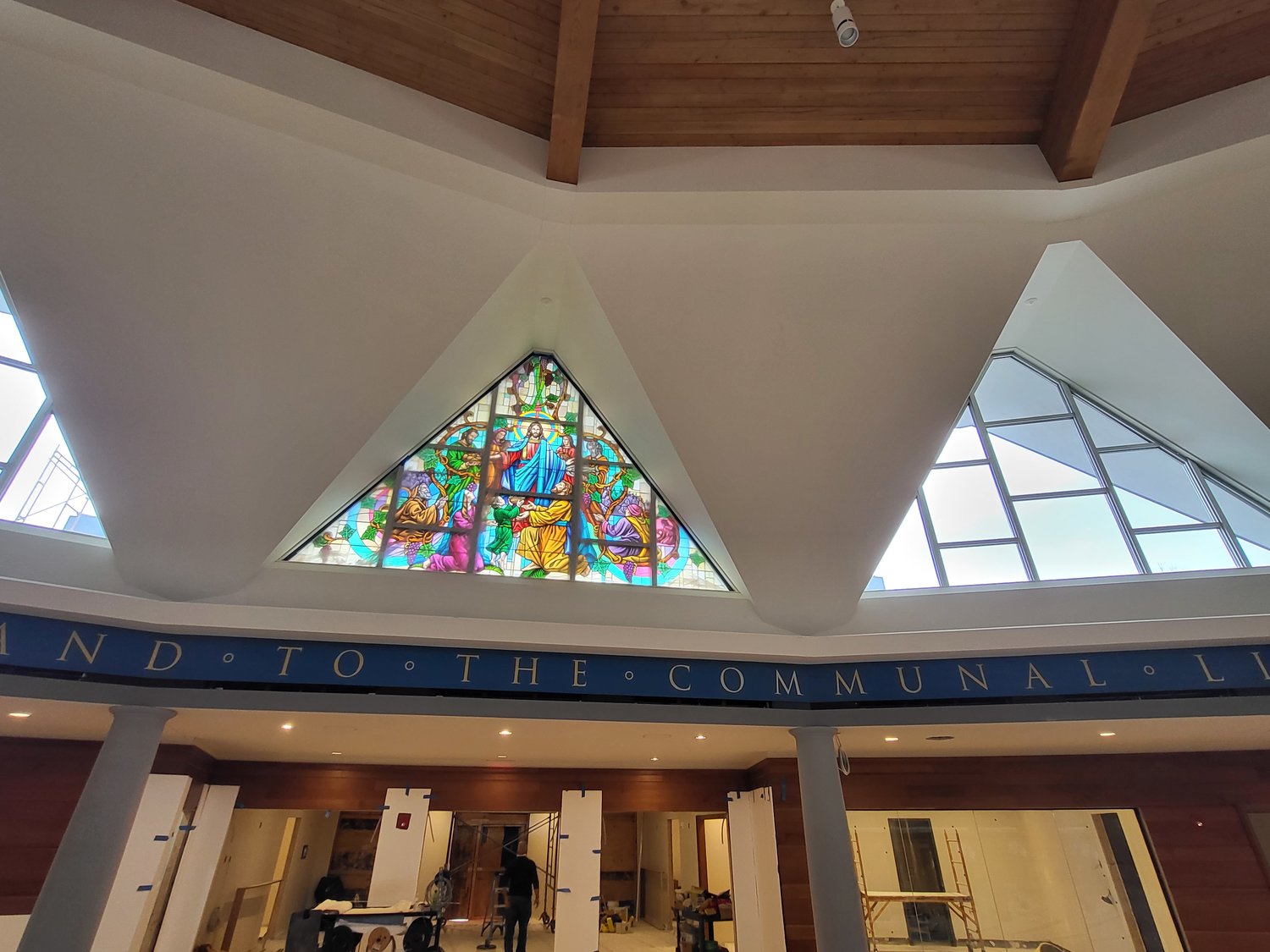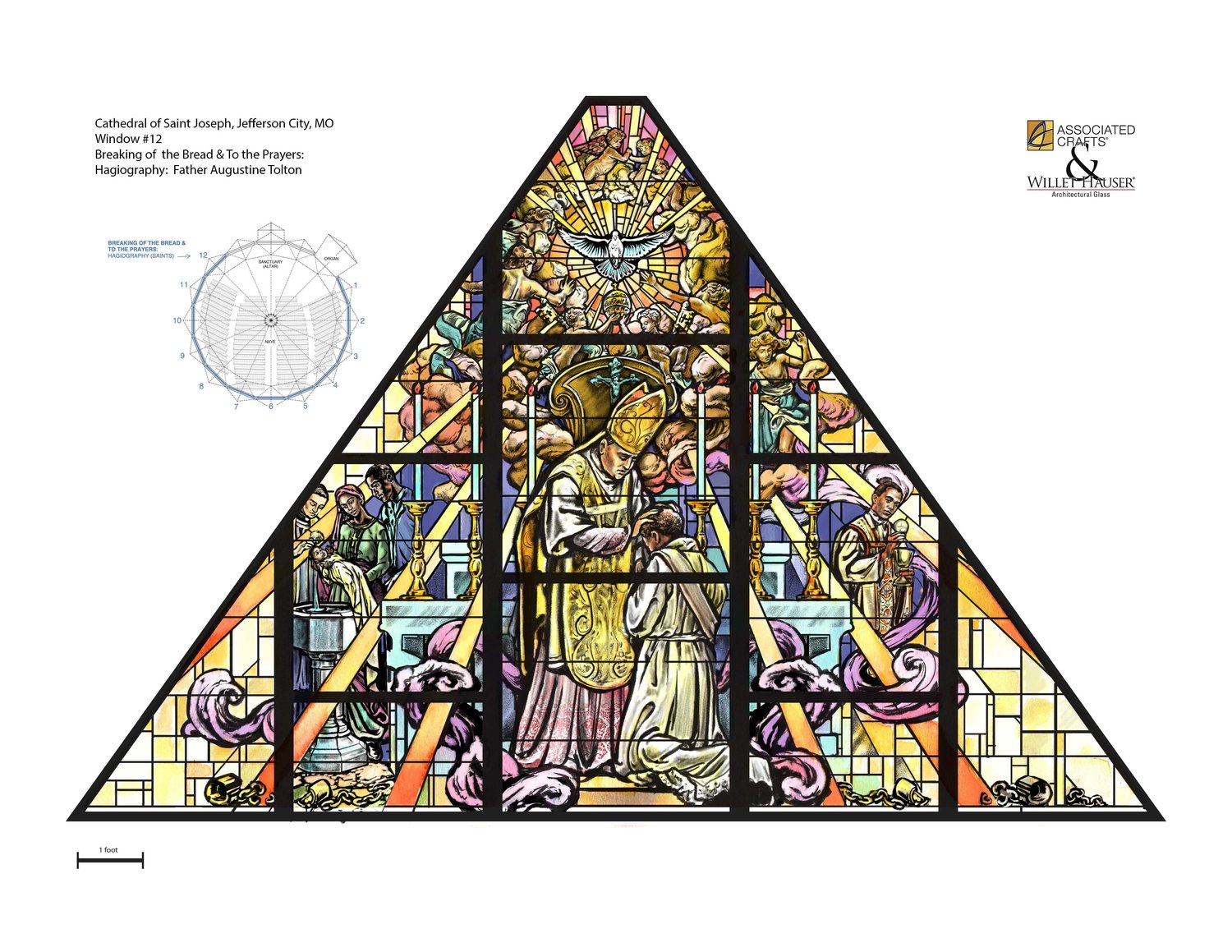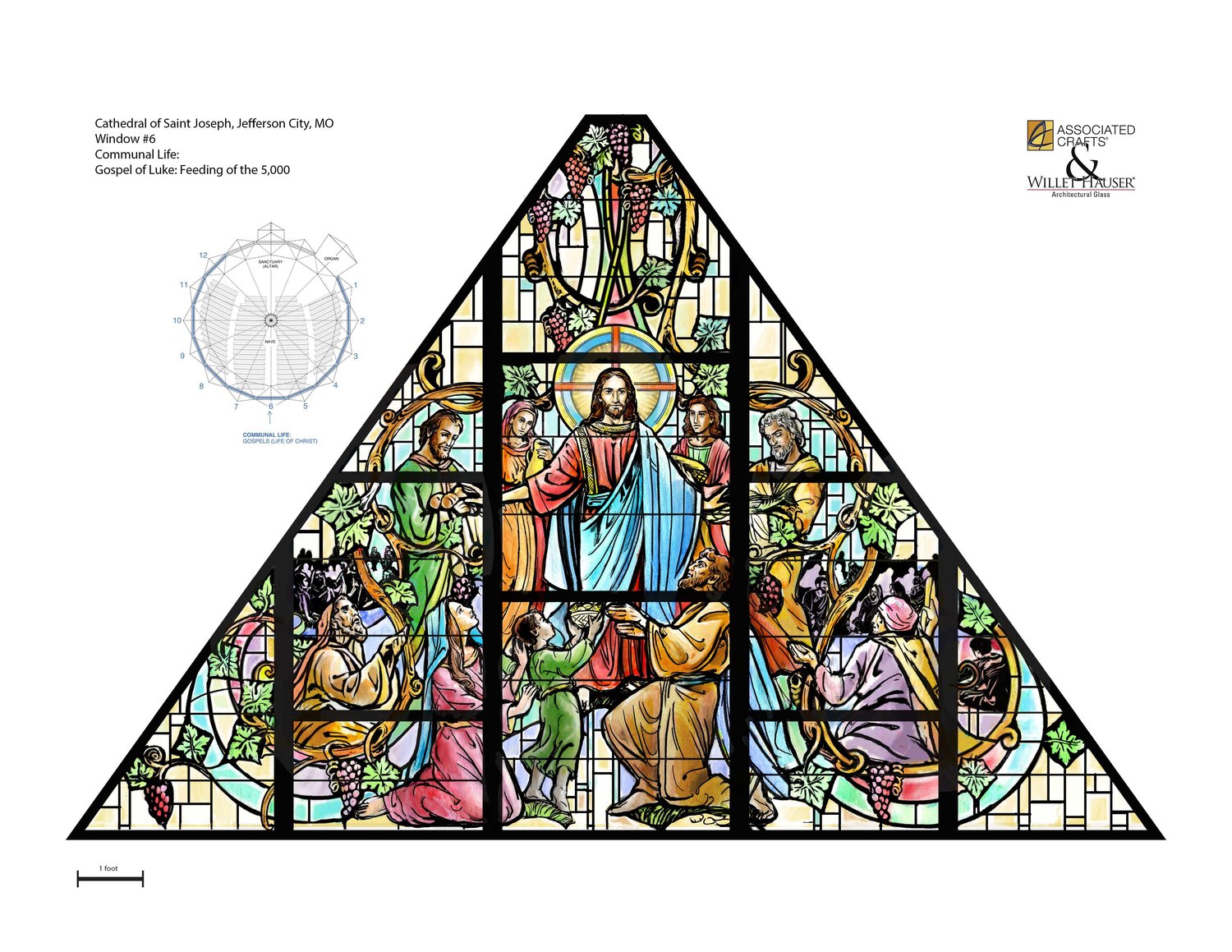Cathedral’s new stained glass windows will filter light through the call to discipleship

The faces of Christ, of Moses, of venerable Father Augustus Tolton gaze down in radiant splendor into the Cathedral of St. Joseph.
And this is just the beginning.
“These imposing images will illuminate our Cathedral, our hearts and our minds in times of communal worship and private prayer,” said Bishop W. Shawn McKnight.
He spoke of the first three of 12 new stained glass windows to be installed in the Cathedral.
All of the windows, which are being created by Associated Crafts & Willet Hauser Architectural Glass Inc. of Winona, Minnesota, are designed to teach people of all ages about discipleship.
Through detailed, hagiographic images of Christ, the prophets, the saints and scores of ordinary people, the triangle-shaped windows will illustrate aspects of verse 2:42 from the Book of Acts: “They devoted themselves to the teaching of the Apostles and to the communal life, to the breaking of the bread and to the prayers.”
Skilled artisans of Willet Hauser designed the windows in collaboration with Bishop McKnight, the members of the Cathedral Renovation Commission, and William Heyer, architectural consultant for the Cathedral renovation.
The purpose of the $15 million renovation, expansion and renewal of the Cathedral is to replace the building’s failing systems while enhancing its beauty, functionality, capacity for hospitality and conduciveness to uniquely Catholic worship.
The work includes upgrading failing electrical, plumbing and air-handling systems, enhancing energy efficiency, replacing the worn-out pipe organ, building a ramp to the sanctuary, installing an elevator, and constructing a sheltered entrance portico, a larger vestibule and additional restrooms to enhance accessibility.
Bishop McKnight has set May 5 for the rededication of the Cathedral.
“Minds won’t wander far from the intended purpose of this sacred edifice, which is to be a house of prayer, a dwelling place for the Lord, an enduring symbol of his reign, a foretaste of heaven and a roadmap for how to get there,” said Bishop McKnight.
The new windows, much brighter than the kaleidoscopic iterations that preceded them, make the Cathedral seem larger and more open.
Each window is filled with colorful images, symbols and subtle reminders.
“This is sacred artwork that teaches even as it beautifies and orients us toward worship,” said Bishop McKnight.
Great panes
The new windows are part of an overall effort to create timeless beauty for the Cathedral.
“This is art that has to live on for a century. It’s a generational project,” said Kathy Jordan, director of art development for Willet Hauser Architectural Glass.
The company describes its work as “Where light learns to speak.”
Stained glass is a highly refined art form, dating from the early Middle Ages.
“It tells a story, illuminates the story and gives meaning to it,” said Ms. Jordan.
Stained glass windows started out as a way to fill churches with natural light while highlighting stories from the Bible in an intensely visual manner, especially for people who couldn’t read.
“As architecture became more sophisticated, the builders made room for larger windows to bring even more light into the space,” Ms. Jordan noted. “Advances in materials and techniques brought more-effective use of color and depth and a broader range of symbols and meaning.”
The designs for the Cathedral of St. Joseph’s new windows went through many phases of development and refinement.
Once the final designs were approved, stained glass artisan Mark Bleakley of Willet Hauser and his staff set about creating the windows, using a palette of custom-colored glass from Germany.
This involves fashioning intricate pieces of translucent colored glass to fit into lead cames — slender, grooved bars of lead — that form the outline of each figure and object.
Using centuries-old techniques, the artisan hand-paints layers of pigment to the surface of each pane to create form, shading and the impression of depth.
This is particularly evident in such details as individual leaves and pieces of fruit and the contours of numerous faces in the background.
The vitreous pigment is applied to the glass and then fired in the kiln at a high temperature, fusing them permanently.
Sea of glass
Mr. Bleakley wrote an official description of each of the three windows that have been installed.
“Window 1: “Moses and the Giving of the Law,” as told in Exodus 34:29.
“Moses descends Mount Sinai,” Mr. Bleakley states, “emerging from the thick cloud that enveloped the mountain for 40 days, where he had received the heavenly pattern of the tabernacle — cherubim above of the ark of the covenant and God’s throne — and the tablets of stone.
“His face is transfigured from his encounter with God, his feet shoeless for he had been on holy ground — just as his original Divine encounter at the Burning Bush where God originally commissioned Moses ‘tell them I AM sent you,’” the artist continues.
An angel holds a scroll containing the five books of Moses, known as the Pentateuch.
“It’s very first words, ‘In the Beginning,’ unfold in imagery of the Creation — the Creating Hand of God (Genesis 1:3), Heavens and the Earth (Genesis 1:1), and the Spirit/Breath of God (Genesis 1:2) “who has spoken through the prophets,” the artist reveals.
Window 6, centered above the entrance of the Cathedral, “is the great turning point of the Gospels — the Feeding of the 5,000, where Jesus reveals Himself to his followers,” according to Mr. Bleakley.
This image is inspired by “The Miracle of the Loaves and Fishes” from the ancient mosaic in the Basilica of Sant’apollinare Nuovo in Ravenna, Italy.
“Jesus stands revealed in the offering, breaking and giving of the Loaves and Fishes,” Mr. Bleakley notes.
“In the foreground, the small boy with the five loaves and two small fishes is brought to Jesus by St. Andrew,” the artist states. “Like this little boy, we enter bringing what little we have to Jesus who offers it up in Himself.”
“We come in need like the poor and blind, kneeling to left and right, but we leave in the abundance of Christ — the Vine — bearing the very Life of God from the Mass to those in ‘a desolate place,’” the artist declares.
Answered prayers
Window 12, a hagiographic depiction of “how we pray,” is titled, “The Ordination of Father Augustus Tolton.”
Born to enslaved parents and baptized in part of what is now the Jefferson City diocese, Fr. Tolton (1854-97) successfully fought to become the Roman Catholic Church’s first recognizably Black priest in the United States.
He is currently under formal consideration to be declared a saint.
“In the center of the window,” Mr. Bleakley states, “Augustine Tolton is ordained in Rome by Cardinal Parocchi in 1886. Thirty-one years earlier, he had been born a slave in Missouri and baptized by his faithful parents (to the left).
“The day following his ordination,” the artist continues, “Fr. Tolton would celebrate his first Mass on Easter Morning beneath the Vatican dove at St. Peter’s Basilica.
“His whole life would be a living testimony to the Holy Spirit working through him,” Mr. Bleakley observes.
“Bringing light in”
Scheduling has been challenging. The war in Ukraine has impacted the stained-glass industry, and delivery needed to be phased.
“The mouth blown glass is from Germany,” Ms. Jordan noted. “Their furnaces run 24/7 by gas, and there have been shortages due to the war.”
Several more windows are scheduled to be installed in July, with the rest of them slated for arrival by the end of this year.
Ms. Jordan said that once the windows are created and shipped, “installation is pretty straightforward,” placing them in the new frames over the transparent protective panes that have already been installed.
Willet Hauser is celebrating its 125th anniversary this year.
“So this project at the Cathedral in Jefferson City is very significant in the history of our company,” Ms. Jordan stated.
The company has initiated a legacy program, digitally archiving its extensive archive of client and project information dating back to the founding.
“We maintain one of the oldest active privately held stained glass libraries in the United States, with a repository of over 18,000 designs,” Ms. Jordan noted.
She recalled how information in the archive allowed Willet Hauser to recreate every aspect of a stained-glass project from the 1960s after a devastating church fire.
“It’s an iconic legacy of American stained glass captured in a century worth of original artwork,” she said.
She pointed to recent studies by the National Glass Association, illustrating the importance of bringing natural light into buildings.
“There’s some fascinating data showing how patients recover more quickly and how students learn and retain more information in spaces with abundant natural light,” she stated.
“It would also apply to sacred spaces,” she said. “Maybe more so. Bringing light in just adds meaning.”
Ms. Jordan sees a movement is taking place in faith communities, many of them Catholic, toward recognizing the significance and power of beauty in leading people to God.
“I hear especially about young people calling for beautification of the places they worship,” she said.
“Worth the wait”
Father Louis Nelen, rector of the cathedral and pastor of Cathedral of St. Joseph Parish, noted the windows “are designed so you still get a fair amount of natural light, but you also get a nice vibrant color.”
“The parishioners wanted more natural light, and that’s what we delivered on,” the priest stated.
He acknowledged that supply chain issues have created delays in completing the renovation.
“But we have worked together very well as a team to overcome that,” he said. “The bishop and I think that when everybody sees the final product, they will be very impressed. It will have been worth the wait.”
Keywords
scroll toComments
Other items that may interest you
Services
The Catholic
Missourian
2207 W. Main St.
Jefferson City MO 65109-0914
(573) 635-9127
editor@diojeffcity.org









